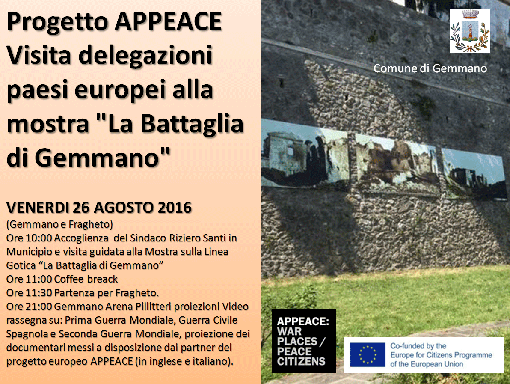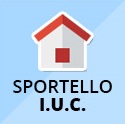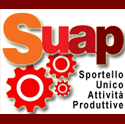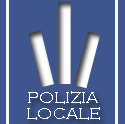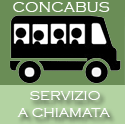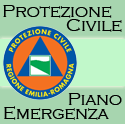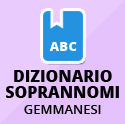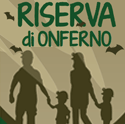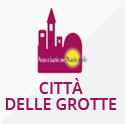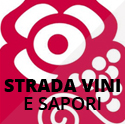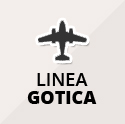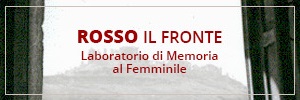Il 26 agosto 2016 le delegazioni pei Paesi partners del progetto europeo APPEACE sono a Gemmano per fare visita alla mostra di gigantografie che raccontano “La Battaglia di Gemmano”…
The project « APPEACE: WAR PLACES/PEACE CITIZENS » was funded with the support of the European Union under the Programme “Europe for Citizens” |
|
Applicable to the Strand 2 – Measure 2.2 “Networks of Towns” |
|
7 events have been carried out within this project:
Event 1
Participation: The event involved 101 citizens, including
- 3 participants from the city of La Jonquera (Spain),
- 2 participants from the city of Sandansky (Bulgaria)
- 1 participant from the city of Kavala (Greece),
- 2 participants from the city of Ieper (Belgium),
- 2 participants from the city of Maribor (Slovenia),
- 2 participants from the city of Usti nad Labem (Czech Republic),
- 10 participants from the city of San Marino (Repubblica di San Marino),
- 2 participants from the city of Brunswick (Canada)
- 1 participants from the city of Munich (Germany)
- 76 participants from the city of Montescudo, Montegridolfo, Gemmano, Riccione, Rimini (Italy),
Location / Dates:
The event took place in Montescudo, Montegridolfo, Gemmano (ITALY), from 20/11/2014 to 22/11/2014
Short description:
The meeting was inaugurated on Thursday November 20th with a welcome by the Mayor of Montescudo Elena Castellari at the Church of Peace in Trarivi (Montescudo).
The morning conference continued with the presentations by the project partners, focusing on the different historical scenarios. Later the conference was attended by Giuseppe Morganti – the Secretary of State for Education and Culture of the Republic of San Marino, Francesca Panozzo (Institute for the History of Resistance in the Contemporary Italy), Laura Carlini (Emilia Romagna region), Marco Musumeci (Ministry of Cultural heritage) and Mario Turci (Director of the Museum of eastern Gothic Line).
At the end of the conference, Umberto Lagari (Curator of the Museum of eastern Gothic Line ) led a guided tour at the Museum of the eastern Gothic Line and the Church of Peace.
The meeting continued with the itinerant focus group such as a visit to the Commonwealth war cemeteries on the territory (in Coriano and Rimini) and to the galleries that hosted Italians displaced to San Marino during the Second World War. The tour was conducted by Patrizia Di Luca (University of San Marino).
The meeting has been attended by the Secretary of State for Culture Giuseppe Morganti, the Secretary of State of Labour and Information Iro Belluzzi and the Coordinator of the Department of History and Culture of the University of San Marino Karen Venturini.
In the afternoon the programme continued with the public meeting on the Gothic Line organized by the Institute for the History of Resistance in the Contemporary Italy in Rimini, followed by a tour to the exhibition “100.000 brothers” by Angelo Turchini (Institute for the History of Resistance in the Contemporary Italy).
On Friday 21st the programme continued with a guided tour at the Museum of the Goth’s Line by the Director Daniele Diotallevi as well as as focus groups conducted by Alessandro Agnoletti and Terzo Maffei on the battle which took place 70 years ago and a report on “Archaeology and anthropology of the displaced” by Sonia Migani.
At the presence of the school class it has been realized the educational workshop “Living in the War: the daily life of civilians and military” learning by doing workshop by Vanessa Del Vecchio.
The afternoon continued with a working session between the partners of the project, focused on defining the calendar of events, the Cooperation agreement, the project management and the sharing of project objectives.
The workshop “Sharing History”, key activitiy of APPEACE project, was realized thanks to coaching led by Manuela Priolo. The purpose of the workshop was to build a weighted grid of the key statements about the Second World War and other wars of the twentieth century.
The day ended at the Theatre Rosaspina in Montescudo, with the special concert “Tour of Italy – the Grand Tour of Italy and Europe” promoted by the “Cultural Association Gan Eden” dedicated to the European project. The music programme combined two artistic paths of the duo Rastelli – Braghittoni, the first dedicated to the popular melodies remained icons of ’900, the second dedicated to European folk music and klezmer contamination.
The third and final day was held in Gemmano, on the morning at the Multimedia Room of the Natural Reserve of Onferno, with the audiovisual story / thematic videoforum with the screening of “The War suddenly” of Silvana Cerruti and film and videos presented by the partners.
The videos were followed by the speech of Lieutenant colonel Mark Belogi (Commando rapid reaction body of NATO in Italy) with a technical presentation on the “History of the Battle of Gemmano”.
On the afternoon, at the conclusion of the meeting, a trekking led by Francesco D’Agostino and Silvana Cerruti in places where civilians took refuge during the battle of Gemmano.
Event 2
Participation: The event involved 51 citizens, including
-2 participants from the city of Montescudo, Montegridolfo, Gemmano, Riccione, Rimini (Italy),
-2 participants from the city of La Jonquera (Spain).
-1 participants from the city of Kavala (Greece),
- 2 participants from the city of Ieper (Belgium),
- 2 participants from the city of Maribor (Slovenia),
- 2 participants from the city of Usti nad Labem (Czech Republic),
- 15 participants from the city of Doiran, Novo Selo, Selo Zubovo, Selo Smolare (Macedonia),
- 25 participants from the city of Sandansky (Bulgaria),
Location / Dates: The event took place in Sandansky (Bulgaria), from 26/03/2015 to 28/03/2015
Short description:
The second event of the project was in Sandanski (Bulgaria) on 26th, 27th and 28th of March 2015, with tour to war memorials from the First and Second World War, the front of Rupel and Doiran in Greece, the Bulgarian cemetries in Novo selo, FYROM(Macedonia) and the Rojden monastry which has witnessed several wars.
The meeting was divided in two parts along the first and second days.
The opening of the first day Thursday 26 March 2015 was focused on the knowledge about Sandanski’s history during the wars, from the First Balkan War to the Second World War. Two speeches took place to illustrate the subject, on one side to explain briefly the history of the Bulgarian army and on the other side to talk about the society during that period of the first half of the twentieth century.
Mr Dimitar Toshev presented ‘Sandanski during the wars’. In this presentation, the speaker talked about the four wars which hit the region: Balkan wars in 1912 and 1913, First World War and Second World War.
After the more theoretical part, the event continued with “the value of the Peace / interactive teaching” in order to examine how the different museums and memory sites work on the subject of peace nowadays. This was the most interesting part to know the different initiatives in the other countries and compare them with the own local projects. Some of the members emphasized the importance of the work about memory with children, as a way of spread the notion of justice and peace.
To conclude, Ms Karaivanova, teacher of a local school, explained the cooperation between German and Bulgarian students who repaired German tombs during 14 days. Two students of the school brought a nice representation of this collaboration. It has been organized a visit at the German flowerbed in the city cemetery and the teacher laid down a spray of flowers for the Germans who died during the first and the second world conflict.
On the second day the meeting continued with tour at war memorials at the death monument in Levunovo (WWI) and the church, built by soldiers during WWI.
Furthermore the event went on with a trip to Rupel, in Greece, for a visit to the military domain with a fort and a museum and to the Doiran Lake, (part of the front during the First and the Second World War) to visit a monument to the disappeared and a cemetery for the Salonica campaign’s victims.
After the visit continued to the British and Greek cemeteries ‘Cimetière Hellenique Doirani’ in Doiran and to Novo Selo (FYROM- Macedonia), to visit another cemetery, dedicated to the Bulgarian victims of the Balkan, First and Second World War.
This second day of the meeting was especially interesting because was possible to visit the physical places where the events took place.
The last day ended with workshop on the liveliness of the twentieth century history, how it still remains nowadays and how it contributes to build up our collective European imaginary.
The day ended with a visit to the oud cloister of Rojen (Rozhen Monastery) and of the Kordopulova House in Melnik.
Event 3
Participation: The event involved 51 citizens, including
-2 participants from the city of Sandanski (Bulgaria),
-2 participants from the city of Maribor (Slovenia)
-2 participants from the city of Usti nad Labem (Czech Republic),
3 participants from the city of Montescudo, Rimini (Italy)
2 participants from the city of Ypres (Belgium),
1 participant from the city of Kavala (Greece)
14 participants from the city of Paris, Elne, Argeles, Perpignan (France),
25 participants from the city of La Jonquera, Girona, Barcellona, Figueres, Portbou, Santa Colomba de Ginet. Agullana (Spain)
Location / Dates: The event took place in La Jonquera (Spain) from 18/06/2015 to 20/06/2015
Short description:
The first day have been welcomed by the Mayor of La Jonquera and President of the MUME Consortium, Sònia Martínez, and the Director of MUME, Jordi Font.
The first part of the morning has been dedicated to the lectures focused on “The peace of the defeated: Francoist repression during the post-war and exile period” and “Memory policies in Catalonia. The cross-border example”, presented by Jordi Gaitx (Scientific Advisor to MUME and UdG) and David González (MUME Education Service).
The second part of the morning has been dedicated to Set-up and Teaching , including a guided tour to the Exile Memorial Museum and presentation of the MUME Education Service, before the “Sharing history” workshop to reflect on historical scenarios during the XX century wars.
In the afternoon, the programme continued with a guided tour around the “Paths of exile”: Agullana, La Vajol, Coll de Lli and the French border, with the participation of MUME Education Service and Enric Pujol (Scientific Advisor to MUME).
In the evening the event continued in Girona to attend the opening of the exhibition “Walter Benjamin. Exile Constellations” (75th anniversary of the death of Walter Benjamin), organised at the Museum of Jewish History.
The second day has been organised in Portbou.
Jörg Zimmer (Walter Benjamin Chair, Memory and Exile, UdG) gave a lecture on: “Fugitives of Nazism crossing the French-Spanish border. Walter Benjamin in Portbou”.
After the lecture, the meeting went on with a guided tour “The retreat and the border during the Second World War”, to the Walter Benjamin Memorial, Coll de Belitres and other memorial sites in Portbou.
In the evening the event’s activities continued at the MUME (La Jonquera) with a discussion about: “The meaning of the borders: past and present”: sharing and personal meaning of the borders in each country. The discussion was followed by the screening of the documentary “Desenterrant el silenci” (Unearthing Silence) by Sergi Bernal on the mass graves of Francoism in Spain and debate with the filmmaker.
The third day ‘s programme was organized at Elne Maternity Home (France) with a lecture on “The French internment camps” given by Serge Barba (testimony descendant of Spanish Republican Refugees) and a visit to the Elne Maternity Home.
The meeting ended in Argelès with a visit to the Valmy Castle, home to the Argelès Camp Memorial.
Event 4
Participation: The event involved 51 citizens, including
2 participants from the city of Usti nad Labem (Czech Republic),
2 participants from the city of Sandanski (Bulgaria),
2 participants from the city of Montescudo, Rimini (Italy)
2 participants from the city of Ypres (Belgium),
1 participants from the city of Kavala (Greece)
2 participants from the city of La Jonquera (Spain),
10 participants from the city of Zadar (Croatia)
30 participants from the city of Maribor (Slovenia)
Location / Dates: The event took place in Maribor (Slovenia) from 18/09/2015 to 20/09/2015
Short description:
From 18th to 20th of September it has been organized the 4th event of APPEACE project in Maribor (Slovenia).
The meeting has been organized by the Museum of National Liberation in Maribor in cooperation with the Drago Kobal Primary School, where the teacher Marjetka Berlič was chosen to manage the cooperation, and with the Prežihov Voranc Primary School, where project coordination was assumed by Natalija Carmona and Klavdija Šipuš.
The first working day started with the activity EDUCATE – Preparation of exhibits and materials at the Museum of National Liberation in Maribor where have been presented the exhibitions, particularly emphasising World Wars I and II. After the presentation and guided tour of the Museum, the meeting continued at the Prežihov Voranc Primary School, at the presence of pupils, the two mentors and the headmistress Janja Bukovec, as well as pupils and mentor from the Drago Kobal Primary School. Firstly there was a screening of a short film on the life in Maribor during World War II, made by a SERŠ student, Peter Berberih, to go back in time and transfer the public to the period in question.
Pupils and project participants were then split into several teams. Each primary school team consisted of two pupils from each school, whereas project participants formed a separate team. Each team was given their own task and topic, all of them related to the theme of war and children at war. Pupils were provided with original documents and object to prepare the final presentation, which had to be in the English language. The topics available were children at war, children refugees today and children soldiers today, stolen children during World War II, illegal children, children from Petriček Hill, children of internment, etc. The way that each group decided to present the topic depended on themselves entirely, which meant that children were able to use their imagination.
Project participants, on the other hand, were given a special task: we had to use the materials given to construct a villa for all of us to live in. We were divided into three groups: the yellow team had all the rights, the blue team were subordinated to the yellow team, yet they retained some of the rights, whereas the red team had no rights at all and had to follow the instructions provided by the yellow and blue teams. They weren’t even allowed to talk within the team. The aim was to experience discrimination and non-verbal communication for ourselves.
The results of pupils’ efforts were exceptional. Based on the topics given, they prepared outstanding presentations. They were creating posters, writing poems, painting and drawing, making their presentations in the English language. Project participants were in agreement about Natalija Carmona and Klavdija Šipuš having prepared really informative and interesting lessons.
In the afternoon, the event continued at the Military Museum of the Slovenian Armed Forces, with a tour of the exhibitions by Mladen Horvat and the participation of the Head of the Museum, Major Zvezdan Markovič. In the Museum, a special emphasis was given on the Slovenian Independence War. At the end of the day there was a visit to the Pobrežje cemetery, to honour the memory of General Rudolf Meister, victims of World Wars I and II, and also lit a candle at the memorial to the Soviet victims of Stalag XVIII D and at the peace memorial. The first day’s programme was concluded by visiting the building that once hosted the Stalag XVIII D camp for prisoners of war.
The following day the event continued the activity Suggestion of the places, tour and itinerant focus on the scene of the Battle of Pohorje. The activities have been conducted in Osankarica, with the presence of representatives of Slovenian Armed Forces. At the exhibition on the Pohorje Battalion, the pupils of Drago Kobal Primary School presented an excellent programme, talking of the final days of soldiers from the Pohorje Battalion and their final battle. The pupils and project participants also joined their voices in song, which resounded across Osankarica.
As planned it was also organized the visit to the site of the final battle of the Pohorje Battalion. Standing by the monument and listening to the song Počivaj jezero v tihoti, it was possible to lit candles and laid a wreath, and the children decorated the monument with stones, on which they had written their names.
Later on, at the exhibition space, there was a screening of a film on the Pohorje Battalion and a workshop for children to compose a draft peace manifesto.
In the evening it was organized a workshop called “Spend the night in the museum” .This is a special programme, which the National Liberation Museum has been organising for a number of years. It is an attempt to teach children some history, while also bringing them closer to the museum and its main task – protection of cultural heritage. This workshop was based on the Circle of Violence. Headed by the museum curator Uroš Dokl, it was possible to learn on how to transform conflicts, how to learn from history, to create links within the group and seek solutions to problems that they encountered on their path. As the strenuous evening programme ended, the participants slept in the museum and in the morning said their goodbyes, full of fond memories.
During the last day, there was a tour of Maribor monuments (Volkmerjev prehod, Meister, a memorial to hostages, a National Liberation Struggle memorial…), after which there was the event celebrating the European Heritage Days at the National Liberation Museum Maribor. This year’s topic being celebrations, Maribor prepared costumed presentations of Slovenian celebrations in the past, be it of national, religious or personal importance.
Event 5
Participation: The event involved 51 citizens, including
2 participants from the city of Maribor (Slovenia)
2 participants from the city of Sandanski (Bulgaria),
3 participants from the city of Montescudo, Rimini, Bolzano (Italy)
2 participants from the city of Ypres (Belgium),
1 participants from the city of Kavala (Greece)
3 participants from the city of La Jonquera, Valencia (Spain),
8 participants from the city of Ankara, Gaziantep, Kutahya, Instanbul (Turkey)
2 participants from the city of Siaulia (Lithuania)
1 participant from the city of Turku (Finland)
1 participant from the city of Presov (Slovak Republic)
2 participants from the city of Sochi (Russia)
1 participant from the city of Krakow (Poland)
1 participant from the city of Rijeka (Croatia)
1 participant from the city of Bucuresti (Romania)
21 participants from the city of Usti nad Labem (Czech Republic),
Location / Dates: The event took place in Usti nad Labem (Czech Republic) from 07/04/2016 to 09/04/2016
Short description:
The conference was opened on Thursday 7 April 2016in the Museum of the City of Ústí nad Labem by the welcome speech of the Lady Mayor of the City – Ms Věra Nechybová and Mr Václav Houfek, the museum manager. The introductory part of the project also comprised the conclusion of the Cooperation Agreement between the Ústí museum and the National Liberation Museum in Maribor, since these two cities have many things in common in terms of history, and the cooperation between the museums will definitely be very fruitful.
The opening of the project was followed by a tour of the most interesting exhibitions commemorating war conflicts. Most time was devoted to the guided tour “Far in the North-West”, documenting the events of 1945 in Ústí nad Labem.
A tour around the city centre was part of the programme which followed the museum exhibitions. The city sightseeing focused on the sites connected to war events – monuments, the church of the Assumption of the Virgin Mary (leaning from its axis since the air raids in WWII), the Beneš Bridge (associated with the tragic events following the violent post-war expulsion of the Germans). The afternoon´s programme was devoted to a visit to the Civil defence museum situated in the former air-raid shelter in the rock below Větruše.
The final event of Thursday’s programme was a workshop entitled “Sharing history” held at the Municipal office to list a series of “key statements” related to the First and Second World Wars. Later on there was a discussion relating to the programme events of the day , the meaning of the whole project, the motivation to take part in such an initiative as well as the further objectives and follow-up activities.
Friday’s programme started with a very compelling presentation prepared by teachers and students of the Elementary school in Trmice, who worked on a project entitled “The Disappeared Langweils”. The presentation also involved a short animated film – “The Key of Life” – created within the project. What is more, it was awarded the grand award by the jury at the international competition of audio-visual work of children and youth up to the age of 26 years – the Animánie Festival, held in Pilsen in October 2015. The participants in the conference did not hide their excitement, not to mention that there was not a dry eye in the house, without exaggeration.
The afternoon programme was devoted to a visit to Terezín (Theresienstadt). First of all, there was a guided tour of the Small Fortress (used as a Gestapo prison for political prisoners and later also for “persecuted” Jews from the ghetto during the Second World War). The next site was the Ghetto museum located in the centre of Terezín, i.e., on sites which were part of the Jewish ghetto during World War II.
The conference ended with a visit on Saturday 9th to the Lidice Memorial and Museum, the infamous town with a tragic fate, burned down by the Nazis in response to the successful assassination of the Reich-Protector, Reinhard Heydrich. The visit started with a guided tour of revered sites (monuments and statues located on the sites where the executions took part or where the school or church used to stand). The tour was followed by a viewing of the modern exhibition in the local museum. Despite the very emotional programme the participants showed excitement and satisfaction with the new experience, information and the inspiration gained for their work.




